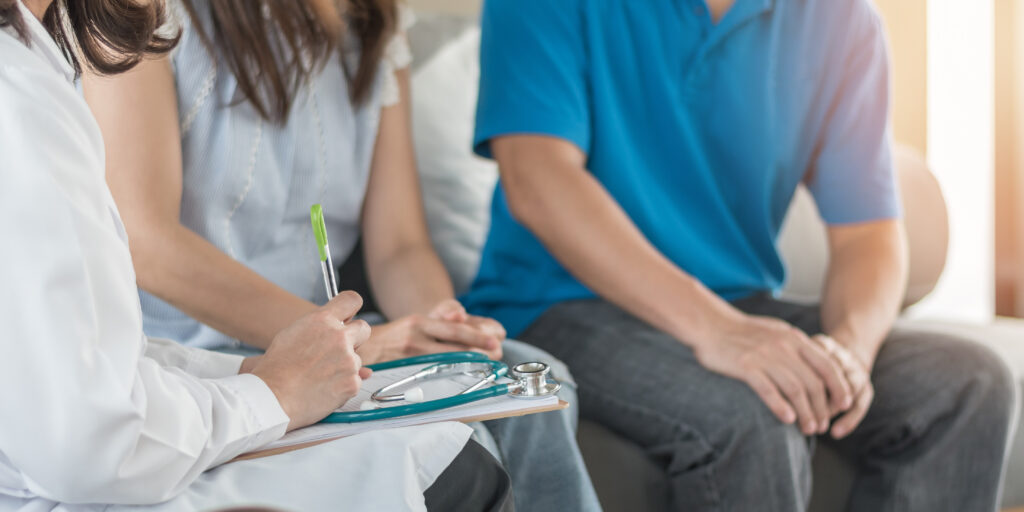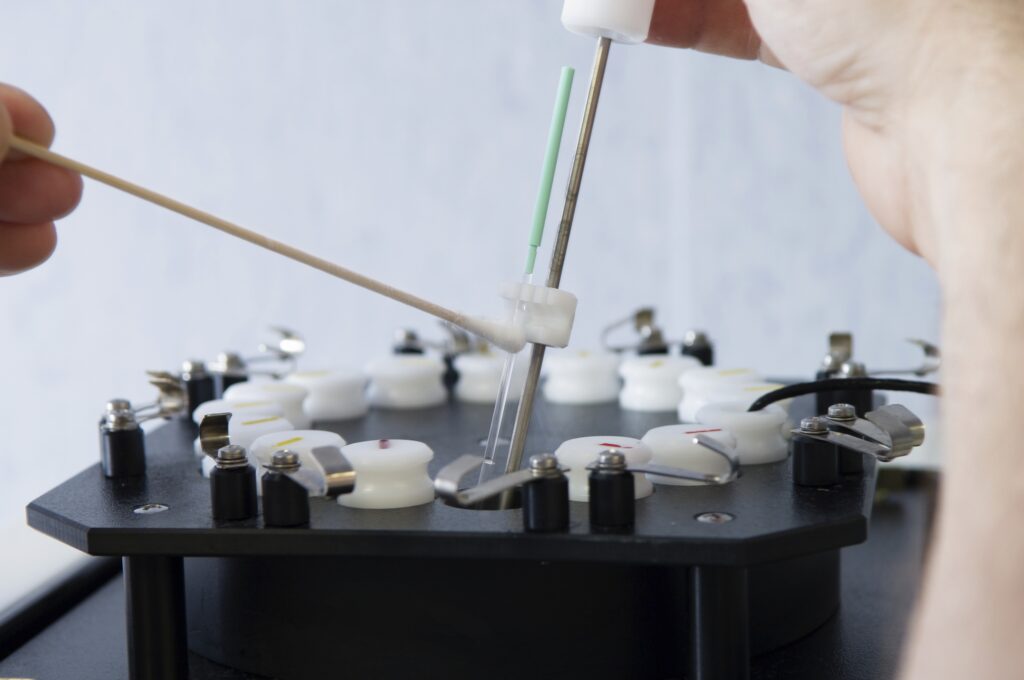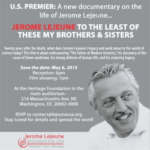Written Testimony of David A. Prentice, Ph.D.: Progress on Kansas’ Midwest Stem Cell Therapy Center Research
*To view as PDF, please see here: Midwest Stem Cell Therapy Center – Kansas’ Unique Initiative
Midwest Stem Cell Therapy Center—Kansas’ Unique Initiative
Written Testimony of David A. Prentice, Ph.D.
Vice President and Research Director, Charlotte Lozier Institute
Adjunct Professor of Molecular Genetics, John Paul II Institute, Catholic University of America
Founding Member, Do No Harm: The Coalition of Americans for Research Ethics
.
Senate Ways and Means Committee
Senate Public Health and Welfare Committee
House Appropriations Committee
House Health and Human Services Committee
State of Kansas
April 30, 2015
The Distinguished Chairs and Honored Members of the Committees.
I am a cell and developmental biologist, currently working for the Charlotte Lozier Institute in Washington, D.C. as Vice President and Research Director; I also serve as an adjunct professor at a Washington, D.C. university, and as an Advisory Board Member for the Midwest Stem Cell Therapy Center, a unique comprehensive stem cell center in Kansas. Previously I spent 10 years as Senior Fellow for Life Sciences at another policy think tank in Washington, D.C., and prior to that almost 20 years as Professor of Life Sciences at Indiana State University, and Adjunct Professor of Medical and Molecular Genetics, Indiana University School of Medicine. Before that I was a faculty member in the Department of Obstetrics, Gynecology and Reproductive Sciences, University of Texas Medical School at Houston. I have done federally-funded laboratory research, lectured, and advised on these subjects extensively in the U.S. and internationally. I’ve taught embryology, developmental biology, molecular biology and biochemistry for over 30 years to medical and nursing students, as well as undergraduate and graduate students. I am proud to be a native Kansan, born in La Crosse, Kansas, raised near Parker, Kansas, with my degrees (B.S. and Ph.D.) from the University of Kansas.
Thank you for the opportunity to testify to you on the progress of the Midwest Stem Cell Therapy Center, a unique Kansas initiative. I was honored to assist with development of the Kansas stem cell center, and testified in favor of the bill, SB199, that made the Center a reality, as well as last year to report on its beginnings. Thank you for your support of this idea. Currently I serve as a member of the Center’s Advisory Board.
Stem cell treatments using adult stem cells from bone marrow, umbilical cord blood, and other tissue sources continue to be a cutting-edge medical technology. I’d like to discuss with you briefly the current state of development for these medical treatments and some examples of their application, the position of the Kansas Stem Cell Center in relation to other centers around the nation, and the view toward the future growth of the Kansas center to bring more treatments to Kansans.
There are at present 3,098 ongoing or completed clinical trials using adult stem cells, listed in the NIH/FDA-approved database,[1] with over 70,000 people around the globe receiving adult stem cell transplants each year, for dozens of different conditions. There have now been over one million adult stem cell transplants total.[2] The applications of adult and cord blood stem cells in clinical therapy are growing, and Kansas continues to position itself as one of the leaders in these therapies. The KU Cancer Center itself performed over 300 marrow and blood stem cell transplants for cancer treatments in 2013, an increase of greater than 30% over the number of treatments for 2012; it is anticipated that this year there will be over 340 transplants. To date the Cancer Center has done more than 2,300 successful transplant procedures.
A substantial amount of previous work with adult stem cells has been the successful application of the cells for treatment and recovery from various cancers. While a number of these therapies have moved into standard medical practice, as seen by the numbers treated at the KU Cancer Center, there is still much work to be done to increase the efficacy of stem cell transplants for cancer and to treat even more cancer types. For example, recently a French group found that they could improve prognostic targeting of adult patients who would benefit from stem cell transplants for acute lymphoblastic leukemia, following a protocol that has been successful for treatment of childhood leukemia.[3] Likewise a new review paper notes that bone marrow adult stem cell transplant remains a curative option for chronic myelogenous leukemia.[4] Other cell therapies known as adoptive cell transfer (ACT) and chimeric antigen receptors-T cell (CAR-T) are being developed, including joint projects at KU Medical Center, to attack cancer directly.[5] Furthermore, a groundbreaking study by MSCTC faculty has advanced a promising therapy using adult stem cells to manage graft-versus-host disease, a problem sometimes seen with transplants for cancer.[6]
Beyond cancer, adult stem cells are also showing therapeutic promise for other diseases and conditions where there has previously been no available treatment option. The published scientific literature now documents therapeutic success in trials of adult stem cells for patients with dozens of other conditions, including heart damage, stroke, sickle cell anemia, spinal cord injury, multiple sclerosis, and juvenile diabetes. Further, a growing number of adult stem cell transplants use cells from additional sources such as mesenchymal (connective) tissue, adipose (fat) tissue, and even nasal tissue, and there is the promise of even more sources such as the solid portion of the umbilical cord (Wharton’s jelly) and amniotic fluid. A published estimate is that here is a 1 in 200 chance that you or I, or anyone living in the U.S., will undergo an adult stem cell transplant during our lifetime.[7]
There continues to be progress using adult stem cells, or stimulating the body’s own adult stem cells, to treat diabetes. The NIH-FDA database lists over a dozen clinical trials at this point. Perhaps the best known is the collaboration between Dr. Richard Burt at Northwestern University and colleagues in Brazil; this group had published results of two earlier studies on approximately two dozen Type I diabetes patients, where the patients were able to stop use of insulin after treatment.[8] That group and others are continuing to expand and improve this treatment trial. As another example, one small clinical trial at Massachusetts General Hospital found that treatment with a vaccine adjuvant could stop the autoimmunity and transiently restore normal blood sugar levels in a group of Type I diabetes patients.[9]
Another autoimmune disease that is showing significant strides in treatment using adult stem cells is multiple sclerosis. Two recent reports point to use of adult stem cells to induce remissions in multiple sclerosis. No standard interventions produce any significant reversal of disability. But an international team led by Dr. Richard Burt of Northwestern University Feinberg School of Medicine has shown that adult stem cell transplants are associated with reversal of neurological disability for relapsing-remitting multiple sclerosis patients.[10] Patients were followed for up to five years after treatment and there was significant improvement after transplant, with 50% of patients showing improvement at two years after transplant, and 64% improved at four years after transplant. No other intervention for multiple sclerosis has shown an improvement in neurological disability for patients. Treated patients also showed significant relapse-free survival (80%) and decreased neurological lesions.
A separate publication from a group led by Dr. Richard Nash of the Colorado Blood Cancer Institute also showed evidence for adult stem cell transplants in remission of relapsing-remitting multiple sclerosis.[11] This group provided a three-year interim report on their five-year clinical study. With 24 patients enrolled in the study, at three years follow-up there were improvements in neurologic disability.
Other neurological conditions are also seeing advances. There continue to be promising signs for the use of adult stem cells in treatment of Parkinson’s disease. A recent proof-of-principle experiment found that mesenchymal stem cells, a type of adult stem cell found in bone marrow as well as other tissues, could be transformed into dopamine-secreting cells and provide long-term relief from Parkinson’s symptoms after transplant,[12] Another recent review shows almost a dozen current clinical trials in attempts to treat stroke using adult stem cells.[13] Furthermore, a commercial effort developing an adult stem cell treatment for ALS (Lou Gehrig’s disease) has published evidence that their stem cell product is effective for neurodegenerative conditions. In a case study involving a patient with myasthenia gravis and motor-neuron disease, the treatment with adult stem cells provided significant relief from symptoms.[14] They have also announced, and presented at the recent meeting of the American Academy of Neurology, that preliminary results from their Phase 2a clinical trial with ALS patients have shown beneficial effects for the patients receiving the adult stem cell injections.[15]
According to several published medical authors, “Hematopoietic stem cell transplantation (HSCT) is the only curative therapy for sickle cell disease.”[16] Donor-derived adult stem cell transplants from bone marrow or umbilical cord blood are curative for children with sickle cell anemia, but adults often cannot tolerate the toxicity of similar transplants. Now, development of a lower-toxicity protocol shows that adults can not only tolerate the transplant but that many can stop taking anti-rejection drugs as well.[17] A total of 30 adult patients with severe sickle cell disease were treated with donor bone marrow stem cells after milder actions to open up their own bone marrow. Twenty-six patients showed long-term stable donor cell engraftment, with no graft-vs-host disease. Half of the patients (15) were able to stop immunosuppressive medication and maintain stable cell function without the drugs to prevent immune rejection of the transplant.
Adult stem cells are also showing some promise at treating inherited conditions. A multicenter trial just reported results of donor adult stem cell transplants for Hurler disease, a lethal genetic condition. The group found that it is imperative to diagnose and treat early, to achieve the best results.[18]
Adult stem cells are also now being used to treat some conditions while still in the womb. There are now several cases where unborn children have been successfully treated with adult stem cells for severe immune deficiencies,[19] and another reported result where unborn children were successfully treated in utero for osteogenesis imperfecta,[20] a genetic condition that causes brittle bones that break very easily.
Adult limbal stem cells (taken from the edge of the eye) have been used in the past to grow new corneas for patients, replacing corneas damaged by chemical burns or other trauma.[21] The limbal stem cells can be taken from the patient’s own damaged eye and used to grow new tissue in vitro for transplant, restoring sight to blind eyes. New research suggests that limbal stem cells could prevent corneal damage and scarring if applied in a timely manner, obviating the need to grow a completely new cornea.[22] Human limbal stem cells applied to corneal wounds in mice prevented the formation of fibrotic lesions, and induced regeneration of new corneal stroma. This represents a potential autologous source of cells to treat corneal damage directly.
Limbal stem cells are not the only cells that can form corneal tissue. Opening the door to numerous jokes about “eye teeth,” a group in Pittsburgh has shown that stem cells from dental pulp can form corneal stroma cells, allowing repair of corneal damage.[23]
Scientists in Pittsburgh have shown that adding a biological protein matrix to a wound can attract and stimulate adult stem cells to restore muscle.[24] In their trial, three out of five patients showed significant muscle restoration in their legs.
Research continues to isolate tissue-specific adult stem cells from various organs, and to identify stem cells and progenitors that may facilitate tissue-specific repair. Three different groups recently reported on stem cells that participate in lung repair. Zuo et al. found specific airway stem cells that could grow and repair lung damage.[25] Vaughan et al. found that previously-unrecognized lung stem cells could regenerate lung tissue after injury.[26] And Pardo-Saganta et al. also found airway stem cells that responded after significant lung injury. [27] These discoveries open possibilities for specific therapies for lung diseases.
A brief article by Petrella et al. showed that another population of stem cells, mesenchymal stem cells from bone marrow, could close a bronchopleural fistula in a patient.[28] The cells were used essentially to plug a hole in a patient’s lung that had developed after surgery. The doctors injected the patient’s adult stem cells near the fistula, and bronchoscopy at 60 days showed complete healing.
In a paper published less than a month ago, a Korean group reported complete healing in 80% of patients treated with adipose-derived adult stem cells for severe fistulae associated with Crohn’s disease, a devastating condition of the digestive system.[29]
Researchers in Poland report significant improvement in a spinal cord injury patient, two years after the injury. The patient received multiple injections of his own bone marrow adult stem cells and found substantial recovery of movement and sensation over time.[30]
At present there is little that can be done to repair injured kidneys; a transplant is the usual solution. But there may be hope for the future from adult stem cells. Italian scientists have shown that they can turn human bone marrow stem cells into functional kidney cells in the laboratory. When transplanted into an animal model of kidney damage, the transformed cells started repair of the damaged kidneys and improved function.[31]
A number of doctors are attempting to treat joint problems with adult stem cells, usually from adipose-derived cells from the patient. Others are looking at the possibility of using donor adult stem cells that could be matched to many patients. A national collaboration of several groups has published results showing that adult stem cells can repair knee joint injury, regenerating meniscus and improving knee pain following treatment.[32] While there is still a lack of published peer-reviewed studies in the area of orthopedic surgery use of adult stem cells, this is an area of significant growth for regenerative medicine.[33]
This area of regenerative medicine treatments also highlights two areas of potential growth for the MSCTC. It is a unique, comprehensive center, focused on patients. This focus includes not only current therapies and trials, but also advancing the frontier of research and therapies to help even more people, providing clinical-grade stem cells for treatments and trials, educating the public as well as professionals about current and developing treatments, and serving as a global resource for patients and physicians. By providing the coordination for clinical trials among clinics and centers doing patient treatments, the Center could facilitate more safe and validated patient treatments, improve collaboration, and increase the knowledge base on best practice for specific adult stem cell applications.
The GMP (Good Manufacturing Practice) facility at the MSCTC is another important area of focus for the Center, and one that could benefit patients and medical practitioners alike. The GMP facility is the heart of the MSCTC, and provides clinical grade stem cells from adult tissues and cord blood for clinical trials, and for scale-up processing of cellular products for potential therapeutic use. This qualified facility meets all U.S. Code statutes, federal regulations, and FDA guidelines. It is specifically designed for cell therapy applications, to develop, manufacture and package cell products. The MSCTC GMP facility is the only such qualified laboratory in this region, and it is on par with the best in the nation.
The GMP facility can provide clinical grade stem cells for projects at KU Medical Center and around the state and region. This includes contract manufacturing for outside clinics, facilities, and companies. The MSCTC was contacted recently by a stem cell research facility in Iowa, to discuss the possibility of stem cell product manufacturing for their projects.
There are an estimated 53 programs nationwide doing research in the stem cell field. In contrast to the MSCTC, most “stem cell centers” around the United States focus on basic research with little or no clinical component. Furthermore, most “stem cell treatment centers” emphasize only specific clinical treatments but do not educate the public or physicians. None of the identified stem cell centers provide a comprehensive program of treatment, research, training and education as does the MSCTC.
Here is a sampling of some of the other stem cell centers in the U.S.:
The Oklahoma Center for Adult Stem Cell Research (OCASCR) is a virtual center, established in 2010 by the Oklahoma legislature with $5.5 million from the Oklahoma Tobacco Settlement Endowment Trust. Its principal activities are promotion of adult stem cell research in Oklahoma, primarily by giving out grants for basic research.
The Regenerative Medicine Program at the University of Nebraska Medical Center, established in 2010, was funded by reallocation of monies within the University of Nebraska Medical Center. While the Nebraska Medical Center does approximately 150 bone marrow transplants per year, the clinical program is not coordinated with the Regenerative Medicine Program, which does basic stem cell research.
The Center for Regenerative Medicine and Cell Based Therapies at Ohio State University, opened in 2012, is solely involved in basic research. The center itself is administrative space, with the actual laboratories scattered across the campus. Funding is from the academic colleges.
The National Center for Regenerative Medicine at Case Western Reserve University is a collaboration between Case Western, the Cleveland Clinic, Ohio State University, University Hospitals at Case Western, and the adult stem cell company Athersys. It was created in 2003 with a $19.4 million award from the Ohio Third Frontier, a state-sponsored technology innovation fund. The Center’s efforts focus on non-embryonic stem cell research and the clinical components do some transplants, but the majority of the work is in the basic science area. Since starting, it has received over $19 million in grants and awards, primarily from state programs.
The Tulane Center for Stem Cell Research and Regenerative Medicine, founded in 2000, was initially supported by funding from the state of Louisiana and Louisiana Board of Regents, the HCA – Healthcare Company and several private foundations. It is presently supported by research funds from the federal government. It has a Good Manufacturing Practice (GMP) facility and does some clinical work, though most of the resources are directed toward basic research.
The McGowan Institute for Regenerative Medicine at the University of Pittsburgh Medical Center was founded in 2001, and the majority of the work is basic research, though significant translational research does take place as well as clinical trials. In 2012, the University of Pittsburgh Cancer Center did 287 adult stem cell transplants. Funding comes primarily from grants and contracts for faculty members from federal agencies. Between fiscal year 2004 and fiscal year 2011, these grants accounted for $85.6 million, according to the institute’s 10-year progress report. Another $19.8 million came from gifts and philanthropy, $15.65 million from University of Pittsburgh Medical Center, and $4.84 million from the University of Pittsburgh.
The University of Minnesota Stem Cell Institute was founded in 1999, and has received more than $43 million in funding, with $39 million of that as NIH grants. It coordinates primarily basic research and education programs in various departments across the university campus. Last year Minnesota made an attempt to copy the Kansas center, in an attempt to move ahead of it. The Legislature awarded nearly $50 million over 10 years last year to form a partnership between the University of Minnesota stem cell center and the Mayo Clinic to further regenerative medicine research and potential clinical applications.
Kansas’ Midwest Stem Cell Therapy Center compares favorably against all of these and other “stem cell centers” around the country. The Kansas Center is unique, comprehensive, and focused on the patients first. It encompasses clinical treatments, basic and translational research, education and training, a valuable resource for cell processing, and a center for stem cell information including development of a one-of-a-kind clinical database. It is already on the path to becoming a focal point for adult stem cell therapies, trials, and collaborations, as well as for education and training.
Kansas can be the leader in adult stem cell therapies and information for physicians and patients around the world.
[1] Search term: http://www.clinicaltrials.gov/ct2/results?term=adult+stem+cell+transplants&type=Intr accessed April 26, 2015.
[2] Gratwohl A et al., One million haemopoietic stem-cell transplants: a retrospective observational study, Lancet Haematology 2, e91, March 2015
[3] Dhedin N et al., Role of allogeneic stem cell transplantation in adult patients with Ph-negative acute lymphoblastic leukemia, Blood 125, 2486, 2015
[4] Barrett AJ and Ito S, The role of stem cell transplantation for chronic myelogenous leukemia in the 21st century, Blood published ahead of print, 2015, doi: 10.1182/blood-2014-10-567784
[5] Rosenberg SA and Restifo NP, Adoptive cell transfer as personalized immunotherapy for human cancer, Science 348, 62, 2015
[6] McGuirk JP et al., Wharton’s Jelly-Derived Mesenchymal Stromal Cells as a Promising Cellular Therapeutic Strategy for the Management of Graft-versus-Host Disease, Pharmaceuticals 8, 196, 2015
[7] Nietfeld JJ et al., Lifetime Probabilities of Hematopoietic Stem Cell Transplantation in the U.S., Biology of Blood and Marrow Transplantation 14, 316-322, 2008
[8] Voltarelli JC and Couri CEB, Stem cell transplantation for type 1 diabetes mellitus, Diabetology & Metabolic Syndrome 1, 4, 2009; doi:10.1186/1758-5996-1-4; Couri CEB et al., C-Peptide Levels and Insulin Independence Following Autologous Nonmyeloablative Hematopoietic Stem Cell Transplantation in Newly Diagnosed Type 1 Diabetes Mellitus, JAMA 301, 1573-1579, 2009; Voltarelli JC et al., Autologous Nonmyeloablative Hematopoietic Stem Cell Transplantation in Newly Diagnosed Type 1 Diabetes Mellitus, JAMA 297, 1568-1576, 2007
[9] Faustman DL et al., Proof-of-Concept, Randomized, Controlled Clinical Trial of Bacillus-Calmette-Guerin for Treatment of Long-Term Type 1 Diabetes, PLOS One 7, e41756, 2012
[10] Burt RK et al., Association of Nonmyeloablative Hematopoietic Stem Cell Transplantation With Neurological Disability in Patients With Relapsing-Remitting Multiple Sclerosis, JAMA 313, 275, 2015
[11] Richard A. Nash et al., High-Dose Immunosuppressive Therapy and Autologous Hematopoietic Cell Transplantation for Relapsing-Remitting Multiple Sclerosis (HALT-MS), JAMA Neurology 72, 159, 2015
[12] Hayashi T et al., Autologous mesenchymal stem cell–derived dopaminergic neurons function in parkinsonian macaques, J Clinical Investigation 123, 272, 2013
[13] Doepner TR and Hermann DM, Stem cell-based treatments against stroke: observations from human proof-of-concept studies and considerations regarding clinical applicability, Frontiers in Cell Neuroscience 8, Article 357, October 2014
[14] Petrou P et al., Rare combination of myasthenia and motor neuronopathy, responsive to Msc-Ntf stem cell therapy, Muscle & Nerve 49, 455, 2014
[15] Petrou P et al., Autologous Transplantation of Mesenchymal Stem Cells Secreting Neurotrophic Factors (NurOwn®) In ALS: Results of a Phase 2 Clinical Trial, Abstract P2.059, AAN Annual Meeting 2015, Washington, DC
[16] Bernaudin F et al., Long-term results of related myeloablative stem cell transplantation to cure sickle cell disease, Blood 110, 2749-2756, 2007
[17] Hsieh MM et al., Nonmyeloablative HLA-Matched Sibling Allogeneic Hematopoietic Stem Cell Transplantation for Severe Sickle Cell Phenotype, JAMA 312, 48, 2014
[18] Aldenhoven M et al., Long-term outcome of Hurler syndrome patients after hematopoietic cell transplantation: an international multicenter study, Blood 125, 2164, 2015
[19] Loukogeorgakis SP and Flake AW. In utero stem cell and gene therapy: Current status and future perspectives, Eur J Pediatr Surg 24, 237, 2014
[20] Chan JKY and Götherström C. Prenatal transplantation of mesenchymal stem cells to treat osteogenesis imperfecta, Frontiers in Pharmacology 5, 1, October 2014.
[21] Rama P et al., Limbal Stem-Cell Therapy and Long-Term Corneal Regeneration, N. Engl. J. Med. 363, 147, 2010
[22] Basu S et al., Human limbal biopsy-derived stromal stem cells prevent corneal scarring, Science Translational Medicine 6, 266ra172, 2014
[23] Syed-Picard FN et al., Dental Pulp Stem Cells: A New Cellular Resource for Corneal Stromal Regeneration, Stem Cells Translational Medicine 4, 276, 2015
[24] Sicari BM et al., An Acellular Biologic Scaffold Promotes Skeletal Muscle Formation in Mice and Humans with Volumetric Muscle Loss, Science Translational Medicine 6, 234ra58, 2014
[25] Zuo W et al., p63+Krt5+ distal airway stem cells are essential for lung regeneration, Nature 517, 616, 2015
[26] Vaughan AE et al., Lineage-negative progenitors mobilize to regenerate lung epithelium after major injury, Nature 517, 621, 2015
[27] Pardo-Saganta A et al., Injury Induces Direct Lineage Segregation of Functionally Distinct Airway Basal Stem/Progenitor Cell Subpopulations, Cell Stem Cell 16, 184, 2015
[28] Petrella F et al., Airway Fistula Closure after Stem-Cell Infusion, N. Engl. J. Med. 372, 96, 2015
[29] Cho YB et al., Long-Term Results of Adipose-Derived Stem Cell Therapy for the Treatment of Crohn’s Fistula, Stem Cells Translational Medicine, published online 31 March 2015, doi: 10.5966/sctm.2014-0199
[30] Jarocha D et al., Continuous Improvement After Multiple Mesenchymal Stem Cell Transplantations in a Patient With Complete Spinal Cord Injury, Cell Transplantation 24, 661, 2015
[31] Papadimou E et al., Direct Reprogramming of Human Bone Marrow Stromal Cells into Functional Renal Cells Using Cell-free Extracts, Stem Cell Reports 4, 685, 2015
[32] Vangsness CT et al., Adult Human Mesenchymal Stem Cells Delivered via Intra-Articular Injection to the Knee Following Partial Medial Meniscectomy, J Bone Joint Surg Am 96, 90, 2014
[33] Murrell WD et al., Regenerative Treatments to Enhance Orthopedic Surgical Outcome, PM&R 7, S41, 2015



























